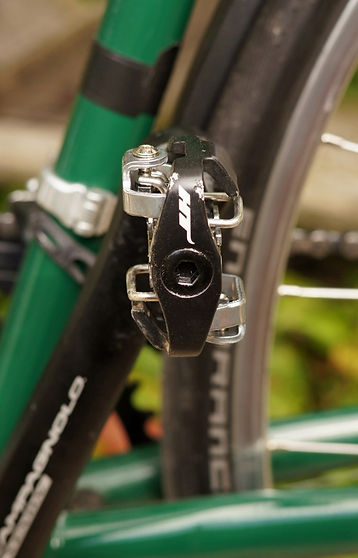
THIS SITE USES GOOGLE ANALYTICS TO ANALYSE TRAFFIC. CONTINUING TO USE THIS SITE MEANS YOU ACCEPT THE USE OF COOKIES.WE DO NOT COLLECT PERSONAL DATA LEARN MORE OR SEE OUR PRIVACY POLICY
SEVEN DAY CYCLIST
CYCLING, BUT NOT USUALLY RACING
LATEST UPDATE DECEMBER 30th 2025
HOW DO WE REACH THE OVERALL RATINGS FOR PRODUCTS WE REVIEW?
HT LEOPARD 878 CLIPLESS PEDALS
380g £39.99pr
The HT Leopard 878 Clipless pedals are a dual-sided design, aimed at cross-country mountain bikers, but make excellent transition to gravel, cyclo cross, and general road riding, too.
Specification
The HT Leopard 878 clipless pedal is HT’s entry level model, sporting a CNC machined cro-moly, axles top-notch sealed cartridge bearings and DU bushings. Pretty much what we’ve come to expect from this price point.
So long as you swerve the jet-washer and similarly ruinous practices, the bearings should turn smoothly for a very long time. That said, stripping, inspecting and re-greasing yearly is good practice.
Titanium certainly shaves grams, but Cro-moly arguably strikes the sweet spot between weight, strength and price. The absence of flats means that removal/fitting is by 8mm Allen key. So long as you’ve greased the threads properly with a stout prep, this shouldn’t be any hardship.


Machined aluminium bodies are closer in style to Ritchey, rather than Shimano patterns, but well-executed and offered in a powder coated silver or satin black livery.
Pedals lead pretty hard lives and silver/polished finishes always age more gracefully than their colour counterparts. However, I’m pleased to report, despite constant dis/engagements, often with soles caked in gritty stones, the satin paint is holding up pretty well.

Cleat/Mechanism
Shimano’s SPD has become the default pattern and its dominance certainly has its advantages -cleat spares are both plentiful, readily available and inexpensive. HT has made the brave move of designing their own. Visually subtly different, some pre-ride investigation confirmed SPD cleats are incompatible.

The electroplated mechanism is more subtle than Time’s legendary ATAC, yet more pronounced than Shimano’s. Theoretically, this provides greater anti-clogging prowess than big S. Release tension is adjusted in the conventional way, via 3mm key. A thin filmy lube such as Muc-Off maintenance spray is enough to keep tarnish at bay.
Standard cleats offer a very reasonable 4 degrees of float but those who suffer from knee trouble will be pleased to note HT also offer an aftermarket set with 8. RRP for replacements is a penny shy of £12 but judging by the past months medley of mud and continuous clipping in/out, they’re wearing at a very pedestrian rate.
Road Performance
There are some riders who will only use a dedicated road pedal with their road bikes. I can see that perspective but, as you’ll probably have guessed by now, I’m not one of them. Dual-sided designs, such as these are perfect for clipless newbies and despite having used various systems over the last 26 years, they’re my first choice for fixed.
Talking of which, HT say these enjoy a reduced Q factor. This is the distance between crank arms (outside to outside). Popular opinion suggested that crank arms, number of gears, chainstay length etc play a leading role. Working on that basis, reducing the Q factor results in a more efficient cadence but that’s not an exact science and beyond the scope of this review.
However, another school of thought says pedals and specifically spindle length, cleat type and how they’re mounted to the shoes are crucial determinants. Common Q factor for contemporary road bikes is around the 150mm mark, 170 for mtbs. In real terms; I didn’t notice any pronounced difference between these and my fleet’s regular pedals.
I was initially a little concerned I might ground one, when installed on my early 90’s road bike, but this evaporated within a few sweeping bends and tight turns. True, I might think twice before recruiting them to a fixed gear conversion with low-slung bottom bracket and 175mm cranks.
However, aggressive; dare we say provocative cornering failed to induce a ground-out. No problems with cyclo=cross derivatives either.


Powering along the climbs, soles beating out as furious tempo, I was delighted by their rigidity and refinement. No hint of creaking, or squeaking here, which isn’t always the case and those bearings are buttery smooth. 60x47mm platforms offer greater support to the feet, thus less fatigue, compared with something like WellgoRC713 https://issuu.com/vortexcreative/docs/sdc_8 (page 15) on rides exceeding 50 miles or so.
In stop go traffic, dis/engagements were super dependable, enabling split second dab-downs and spirited getaways at the lights. Save for the light, grimy patina that tends to collect given a few weeks, or the odd leaf blown up along the lanes, embedded muck has not been significant.
Trail

Swapped over to my Univega for some mixed terrain fun. Charging through the gloop, the cleat mechanisms does a decent job of churning out the crud before it could become impacted and create mischief.
I wasn’t expecting them to Rival Time’s ATAC https://issuu.com/vortexcreative/docs/sdc_8 (page 14) - they didn’t. The jury’s out as to whether it’s conclusively better than Shimano’s. Wet, heavy clay soil tended to cling on but not to the point where it interfered with engagement or release.
Conclusion
Overall, the HT Leopard are an excellent alternative to Shimano’s justly revered M540 and might prove a better option for those seeking more float but wanting a system closer to big S than to Time.
Cross-continental/expedition tourists determined to go the clipless route are arguably best sticking to M540/similar, purely on the grounds of spares availability. Good value in terms of specification, at the other extreme, newbies experimenting with clipless systems may find one of the sub £20 Shimano homages a more cost-effective introduction.
Verdict 3.75/5 Well-engineered pedals with generous float and mud shedding prowess. However, unique cleat will divide opinion.
Michael Stenning





